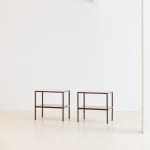




Joaquim Tenreiro
Solid Rosewood, Glass
A 27.95 in. x W 29.13 in. x D 19.5 in.
Further images
This gorgeous pair of Side Tables was designed by Joaquim Tenreiro (1906-1992) and produced in the 1960s. The pieces are made in solid Rosewood ans present two tops: one in Rosewood and the other in glass.
This is the perfect choice to complete living rooms or bedrooms compositions, allowing to exhibit objects under the glass top without compromising the table’s usable space.
Tenreiro came to see the often heavy, overstuffed pieces that dominated the market as being incompatible with a tropical country like Brazil. He promoted furniture that was formally light, as described in his own words: “Lightness, which has nothing to do with the weight per se, but with grace and functionality in space.”




